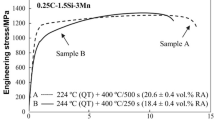Abstract
A two-step quenching and partitioning (Q&P) treatment was applied to low-carbon alloy steels. The relation of initial martensite - retained austenite - fresh martensite and its effect on microstructure and mechanical properties were investigated by experiments. The results reveal that the volume fraction of retained austenite can reach the peak value of 17%, and the corresponding volume fractions of initial martensite and fresh martensite are 40% and 43%, respectively, when the tested steel is treated by initial quenching at 330°C, partitioning at 500°C for 60s and final quenching to room temperature. Moreover, the micromorphologies of austenite and martensite become finer with the increasing of initial martensite fraction. The elongation is the highest when the volume fractions of initial martensite and retained austenite are 70% and 11%, respectively, meanwhile, the yield strength increases and tensile strength decreases gradually with the increase of initial martensite fraction, which proves that the mechanical properties including elongation, yield strength and tensile strength are based on the comprehensive effect of the retained austenite fraction, the finer microstructure and austenite stability.
Similar content being viewed by others
References
Huang X F, Liu W L, Huang Y Y, et al. Effect of a quenching-long partitioning treatment on the microstructure and mechanical properties of a 0.2C% bainitic steel. J Mater Process Technol, 2015, 222: 181–187
Knijf D D, Petrov R, FÖjer C, et al. Effect of fresh martensite on the stability of retained austenite in quenching and partitioning steel. Mater Sci Eng A, 2014, 615: 107–115
Karbasian H, Tekkaya A E. A review on hot stamping. J Mater Process Technol, 2010, 210: 2103–2118
Liu H P, Lu X W, Jin X J, et al. Enhanced mechanical properties of a hot stamped advanced high-strength steel treated by quenching and partitioning process. Scripta Mater, 2011, 64: 749–752
Cai Z H, Ding H, Xue X, et al. Unique serrated flow dependence of critical stress in a hot-rolled Fe-Mn-Al-C steel. Scrip Mater, 2013, 68: 865–868
Speer J G, Matlock D K, Cooman B C D, et al. Carbon partitioning into austenite after martensite transformation. Acta Mater, 2003, 51: 2611–2622
Matlock D K, Speer J G. Third generation of AHSS: microstructure design concepts. In: Microstructure and Texture in Steels. Spring, London, 2009. 185–206
Speer J G, Edmonds D V, Rizzo F, et al. Partitioning of carbon from supersaturated plates of ferrite with application to steel processing and fundamentals of the bainite transformation. Curr Opin Solid State Mater Sci, 2004, 8: 219–237
Clarke A J, Speer J G, Matlock D K, et al. Influence of carbon partitioning kinetics on final austenite fraction during quenching and partitioning. Scrip Mater, 2009, 61: 149–152
Xie X Q. Research on the microstructure and properties of new type martensitic steel obtained by Q&P process. Master’s Thesis, Central Iron & Steel Research Institute, 2008
Wang C Y. Investigation on 30GPa% Grade Ultrahigh-strength Martensitic- Austenitic Steels. Ph. D. thesis, Central Iron & Steel Research Institute, 2010
Xiong X C, Chen B, Huang M X, et al. The effect of morphology on the stability of retained austenite in a quenched and partitioned steel. Scrip Mater, 2013, 68: 321–324
Koistinen D P, Marburger R E. A general equation prescribing the extent of the austenite-martensite transformation in pure iron-carbon alloys and plain carbon steels. Acta Metall, 1959, 7: 59–60
Olson G B, Cohen M. A mechanism for the strain-induced nucleation of martensitic transformations. J Less Common Metals, 1972, 28: 107–118
Hsu T Y. Martensitic transformation and martensite. Beijing: Science Press, 1999. 23–25
Wang C Y, Shi J, Cao W Q, et al. Study on the martensite in low carbon CrNi3Si2MoV steel treated by Q&P process. Acta Metall Sin, 2011, 47: 720–726
Wang C Y, Shi J, Cao W Q, et al. Study on uniaxial tension properties of steel treated by Q&P process. T Mater Heat Treat, 2010, 31: 77–83
Porter D A, Easterling K E. Phase Transformations in Metals and Alloys, Chapman & Hall, London, 1992
Sugimoto K, Usui N, Kobayashi M, et al. Effects of volume fraction and stability of retained austenite on the ductility of TRIP-aided dual- phase steels. ISIJ Inter, 1992, 32: 1311–1318
Author information
Authors and Affiliations
Corresponding authors
Rights and permissions
About this article
Cite this article
Wang, C., Chang, Y., Li, X. et al. Relation of martensite-retained austenite and its effect on microstructure and mechanical properties of the quenched and partitioned steels. Sci. China Technol. Sci. 59, 832–838 (2016). https://doi.org/10.1007/s11431-016-6045-y
Received:
Accepted:
Published:
Issue Date:
DOI: https://doi.org/10.1007/s11431-016-6045-y




